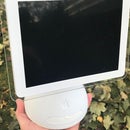Introduction: Apple II Floppy Hackintosh I7-7700 3.6Ghz
This first image is to give you reference to a pristine drive (with the original rainbow Apple logo), mine is has a little more mileage on it. The second image is the internals, I forgot to take a picture before I dismantled it, so courtesy of Google. Here are the parts I used to replace the innards:
- CPU: i7-7700 (non-K version), 3.6Ghz quad core with Hyperthreading
- RAM: 2x16Gb SODIMM DDR4-2400
- SSD: 250Gb WD-Blue M.2
- Wifi/BT: From a Lenovo donor Laptop
- Speakers from an unknown donor laptop
- IR Sensor from donor Macbook
- SuperDrive from donor Macbook
I saw the original Mac Mini Core Solo (1.5GHz) put inside the Apple II floppy drive (2009, Charles Mangin), but I wanted more horsepower. I have upgraded several Mac Mini Core Solo to T7600 Core 2 Duo 2.33 GHz, but I still wanted more horsepower than that. I looked into the NUC motherboards, but the CPU is fixed and not upgrade-able. I ended up buying an ASUS H110 DeskMini (case and Mini-STX motherboard) barebones, used off eBay [DeskMini next to my used Floppy Drive]. Once I installed my CPU and memory, upon powering up the motherboard smoked. I didn't like the cheesy SATA adapters, so I bought a new GigaByte Mini-STX. Since it was new, I thought it would be updated, but no. The firmware needed to be updated to support the i7-7700, so I bought the cheapest same-socket CPU I could find just to update the firmware.
To test all my components before even attempting Hackintosh, I of course loaded Windows and validated everything. I used AIDA-64 to export the component list for reference when trying to find Hackintosh kexts.
The physical build went slowly (three months of spare time) due to constantly building and disassembling components to test fit and adjust items as needed. Sure, things can go wrong, mistakes were made, adjustments created, and sometimes a little "Who cares" had to be applied. Some of these steps were developed at the same time, and some compromises had to be made.
Step 1: Base Mods
1. Disassemble the Apple ][ Floppy Drive. Remove the 4 screws on the bottom holding the case cover on. Remove the case cover. Remove the 4 screws on the bottom holding the drive frame to the base plate. Remove all cables and control boards. At this point, I removed the top latch mechanism for later re-engineering.
2. Make room for the motherboard. I still need the front face-plate mounted, so I cut off as much of the drive frame as possible to still retain the front face-plate mounting holes. I used a hacksaw and manually cut several lines until I had it the size I wanted, then hand filed all cut edges smooth. As parts were added later, further modification and reduction had to be made. As you can see, all the motherboard front connectors cannot be used (audio in/out, USB3, USB-C).
3. Cut holes for the IO plate and motherboard mounting posts. At this point, I did not plan on repainting the case, so I taped it off with masking tape to protect the original paint. I drilled holes in the corners and one large hole to use a jigsaw to cut out the rectangular hole.
4. Airflow. I also noted there was no real way for air to move through the case so I decided to vent it out the back. A hole for air exit means you need a hole for air entry as well, so I put one on the bottom where nobody should see it. I saved the original Apple sticker and placed it under the motherboard for safekeeping. I added some expanded metal to cover the holes. I didn't really want to spend all the time with epoxy to bond everything so I took the easy route of pop rivets. The motherboard mounting posts were off, so I had to adjust those as well. More holes, moved holes, and other adjustments, resulted in me eventually repainting the base.
Step 2: Optical Drive
4. Slot load CD/DVD in the floppy slot. I have an Apple Super-drive from a MacBook, but it was a little too thick to mount low enough. I cut off a small piece of the face-plate with a hacksaw blade held by hand (it is soft plastic) Note the hole for the IR sensor. Then to mount the front to keep it level, I found some hard plastic (maybe Delron) and made a couple plugs to slide into the face-plate.
5. The fan that came with the i-7-7700 was the Intel default, but too tall for mounting in the optical drive. I replaced it with a low profile fan (orange). A strip of 1 inch aluminum was used to make a bracket to mount the back of the optical drive. After several adjustments, this is the final. The two motherboard offsets mounted on this bracket hold the floppy latch to the front face-plate. The other bracket holds the exhaust fan in place.
6. Faceplate Floppy latch. There is just not enough room in this case to put all the originals back in, so I had to make a shorter bracket for the faceplate latch. Here it is next to the original. Mounted in the open position and closed, and with a dvd being ejected!
Step 3: IR Sensor and Additional USB Ports
8. InfraRed Remote (IR). Taken from a MacBook and simply soldered to a USB cable, it works. The intent is to connect to the front facing USB port as it was closest to face-plate for mounting. I found a USB expander with dual USB3, USB-C, and audio in/out, but , so that expander would need to use that port instead of the IR sensor. But the expander option got nixed, and the IR sensor took the USB interface anyway.
9. Extra USB ports. Since the rear IO shield only has two USB-3 ports, and the front ports are now internal (and blocked from use), I decided to add an expander face-plate to the right side of the case. It only shows up on OSX as USB2, so going with an alternate port. USB-C to USB3.0 adapter from an HP laptop. I found a spot under the right side of the face-plate mount that was just the right distance. A little filing and a hole cut in the adapter casing for the top case screw nut made it fit just right while holding it in place.
See the IR sensor in action, as I clumsily navigate KODI on this hackintosh.
Step 4: Power LED and Internal Speakers
10. Indicator lights. The original floppy drive only has an "In Use" red LED indicator. I also wanted to see power. Not wanting to change the front look, I opted for a multi-color LED being Red/Green. The LED I purchased from MicroCenter has a common ground, but the signals coming off the motherboard are common +5v with open/ground for signaling. This means I had to add an NPN transistor and a couple resistors as a NOT gate for the drive activity light to flash red in use, while still showing Green for power on. Several versions of breadboards and testing leads to a tangled mess covered in hot glue (but it is internal, so aesthetics are not needed). Last minute change, I went with the super bright blue/red combo instead. It was a crystal clear package, so I sanded the front to dull the colors (does not show color well on the video).
11. Internal Speakers. Most macs have internal speakers. I have not seen a Hackintosh with internal speakers. So I noticed the GigaByte has a 2W (4ohm) internal speaker output, so I salvaged some laptop speakers and connected them. Worked great in Windows, so found the correct kext to enable them on Hackintosh. The speakers are internal, so sound does not come out very loud, but they are still there as an option.
Step 5: Repaint the Base
13. Re-paint. Since so many exposed holes were made, I decided to repaint the base. To keep it looking stock, the closest I could find was Almond in a Satin finish instead of stock matte. I moved all available original stickers to anywhere available.
Step 6: Final Assembly
A picture is worth a thousand words?
Step 7: Benchmarks
Standard Geekbench 4 (not bad, eh?)
CineBench:
- COMMENT=MAXON CINEBENCH is based on the high performance animation and rendering software MAXON CINEMA 4D.
- CORES=4
- LOGICALCORES=2
- MHZ=3601.000000
- PROCESSOR=Intel Core i7-7700 CPU
- OSVERSION=OS X 10.13.4
- CBCPUX=802.005013
- CBOPENGL=32.383449
- C4DINFO=Intel HD 630 Floppy Mac
- C4DVERSION=15.037
And a couple photos under full load courtesy of my iSeek thermal camera (ooh, the rainbow!). Idle temp around 50C (CPU).

Participated in the
Colors of the Rainbow Contest













